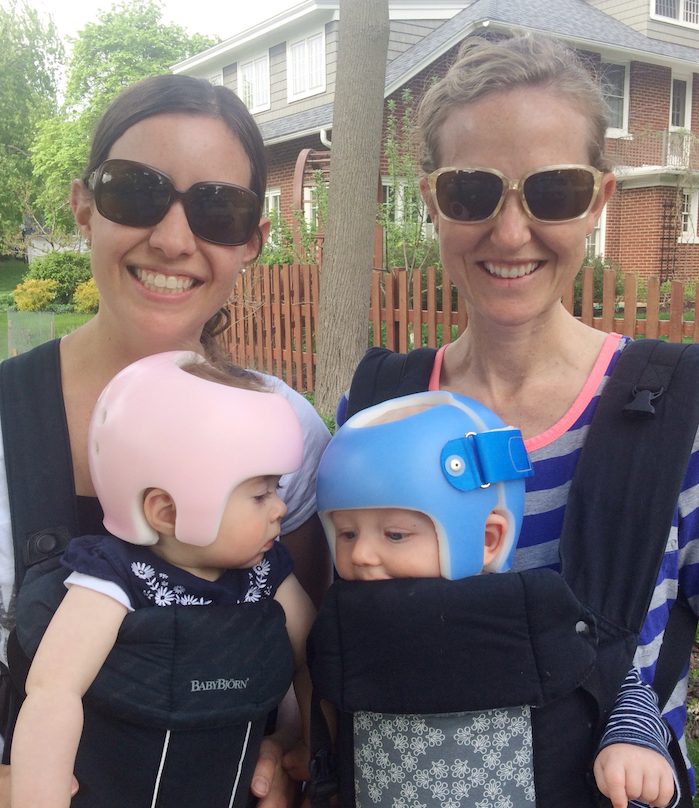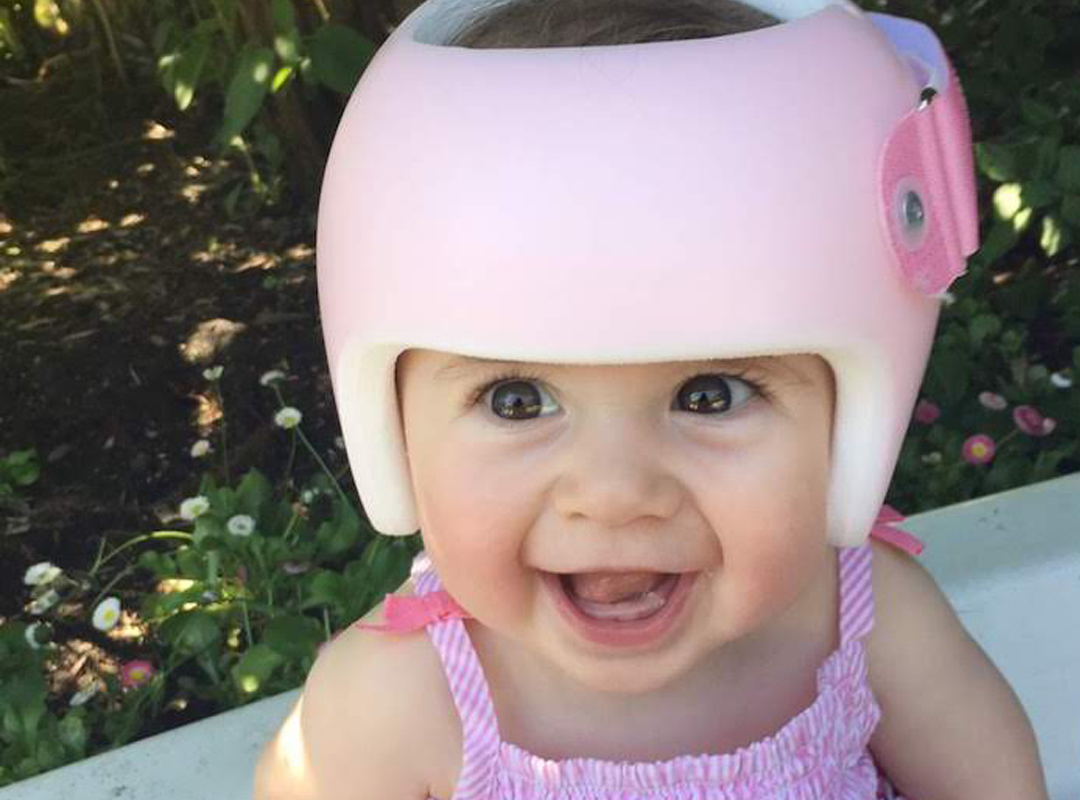When my youngest daughter was about four months old, I started to notice a flat spot on the back of her head. I knew since babies slept on their backs, sometimes they developed little bald and mild flat spots. But, then, I noticed she had a bump on one side of her forehead and decided to ask the pediatrician about it at our next visit.
Our ped confirmed my baby had torticollis—a shortening or tightening of the muscle that goes from behind the ear to the front of the neck. It’s the muscle that helps your baby turn their head. My daughter had a clear preference to turn to one side, contributing to what I’d later learn was her positional plagiocephaly.
She and I left the office with a pamphlet on exercises to reposition her head opposite her preference, a referral to pediatric physical therapy, and a follow-up appointment to check progress one month down the road. A month later, her torticollis and plagiocephaly hadn’t improved enough, so she was referred to an orthotics specialist to get her fitted for a baby helmet.
Now, I think babies in helmets (and babies in glasses) are guaranteed to get smiles from strangers, but it’s tough being the parent going through the stress of having a child with any kind of “diagnosis.” Not only are you worried about your child’s health, but you may also be stressing about the cost of treatment and the time needed for so many therapy and medical visits.
So, what to do if you’re a new parent worried your baby will need helmet therapy? Here are answers to some common questions about baby helmets from research, experts, and moms who’ve been there.
What are baby helmets used for?
Simply put, helmets (formally known as Cranial Remolding Orthosis—CRO) help correct a baby’s skull shape by redirecting a child’s head growth.
According to HealthyChildren.org, “the most common cause for baby helmets today is a positional head shape deformity or positional plagiocephaly. In a small percentage of cases, children with an abnormal head shape have craniosynostosis.” As they mention, this condition occurs when there is an abnormal fusion of the skull bones that results in abnormal skull shape and restricted brain growth. This condition is corrected by cranial surgery and may also be followed by postoperative helmet therapy.
For the more common positional head shape deformity, the helmets are custom-fitted by a cranial specialist for each baby to allow growth where they need it. Lance Weersma, CO, a certified orthotist at Mary Free Bed Rehabilitation Hospital, shared the process with us, “The concept is quite simple. We scan the child’s head and use that shape to create a larger and more symmetrical or better-proportioned helmet. The helmet then holds the areas of the skull that we do not want to see growth and then allows void for the skull to grow into. There is never any pressure that should cause pain or injury as there is always room in the helmet for the child to grow into.”
He added, “when the helmet is used as recommend and the child grows as expected, there is always a positive outcome.”
Why are baby helmets more common now?
The institution of the Back-to-Sleep program in 1994 has significantly reduced the likelihood of SIDS and the guidelines are so important to follow, but more babies today are developing mild flat spots on the sides and backs of their heads. By spending so much time on their backs, flat spots develop easier, and core muscle strength takes longer to develop.

How will I know my baby needs a helmet?
In those early months, you’re seeing your pediatrician often. Keep an eye out for head asymmetry, flat spots, an unusually prominent forehead, or a cone-shaped crown, and bring it up at your next appointment. Your pediatrician will be the one to provide a referral to therapy or an orthotist consultation.
Karen Munger, MSPT, a physical therapist specializing in pediatrics from the Center for Physical Rehabilitation, shared with us some other signs to look for in your baby, including favoring one side, tilting their head to one side (ear to shoulder), reaching with only one of their hands, or rolling only one way.
Because your baby is growing so rapidly, the earlier the diagnosis, the quicker it usually takes to correct it with physical therapy, helmet therapy, or a combination of the two. Often, Munger begins her work with infants between two to four months old.
What can I do to help avoid a baby helmet?
First, you are not a failure if your baby needs helmet therapy. Many times, babies are even predisposed to torticollis from positioning in the womb. There are certain things you can do at home to help.
Try to have at least 30 minutes of tummy time per day in total. If your baby won’t tolerate traditional tummy time, Munger suggests laying them on your chest if you’re reclining on the couch. That way, their muscles are still doing the work but they may be happier being held.
When babies are small, they love to look at your face, so Munger recommends letting them look at you from either side. She also recommends putting babies down the opposite way each time you lay them down to sleep. Babies are more likely to face the door where their parents come in, so by alternating their sleeping position, the direction where they turn their head to look for you also changes. You can also make sure you’re switching arms when you’re holding them.
Munger also advises against letting babies sleep in car seats because babies tend to tilt to one side when they are in their car seats for an extended period of time. This tilt can contribute to them favoring that side.
When babies are older than two months, they may show interest in toys and you can move a toy across your baby’s view that forces them to turn their head both ways to strengthen their muscles. Your pediatrician can also provide you with repositioning exercises if you’re concerned.
When are babies most often diagnosed?
Weersma typically begins treatment with babies at 4-6 months of age, after repositioning has been attempted. Baby’s skulls are soft for a reason since three-quarters of brain growth occurs by age 2. According to HealthyChildren.org, helmets are not effective once a child’s brain growth is complete and Weersma shared the devices are only FDA cleared to the age of 18 months.
In moderate or severe cases of torticollis, long term effects can include gross motor difficulties, vision problems, facial and ear asymmetry, and asymmetric jaw development if left untreated, according to Mary Free Bed Rehabilitation Hospital, where my daughter was treated.
HealthyChildren.org also states that uncorrected plagiocephaly will not influence a child’s neurological development, but it could affect a child’s social well-being later in life if the abnormality is noticeable to peers.
How long do babies have to wear the helmet?
Again, the earlier your baby is diagnosed, the quicker their skull is growing and likely will mean a quicker correction. This is different in every case and so much depends on the age helmet therapy started. In early infancy, the brain and skull grow very quickly. Therefore, the helmet can direct growth over a shorter time.
The orthotist will check your child’s progress at each visit to see if their head shape is improving. In some cases, a short one to two months may be all that is needed. In other cases, it may be longer, sometimes even requiring a second helmet. Weersma shared that, on average, treatment tends to be 4-6 months for most children.

Is a baby helmet uncomfortable?
Generally, it is recommended that babies wear their helmet 23 hours a day, only removing it for bathtime and for cleaning. Babies are easily adaptable, and my daughter was used to hers within a couple of days. Of course, some babies will tolerate it better than others.
“There should be no pain associated with the helmet,” says Weersma, “after all, it’s something the babies wears all the time, like a diaper. If the caregivers embrace it with a positive attitude, the baby likely will too.”
My daughter also had to wear her helmet in the heat of summer and did develop some skin irritation. Our orthotist recommended she have a few 20-minute breaks throughout the day, rather than one hour-long break period. I also bought her a protective sun hat a few sizes up to help keep her shaded and cooler when we were outside.
What’s the one thing you wish you’d known about baby helmets?
Our orthotist said the helmet would bother us more than it would bother the baby, and she was right.
Part of me was upset about the barrier between my baby’s head and baby snuggles for those two months, but I knew it was best for her. Plus, her oldest sister loved to decorate her helmet in princess stickers, so it helped with sibling bonding.
You may get a few stares from people who are likely just curious about why your adorable little baby is sporting a helmet, so try not to worry about what’s going on inside their heads. I was pleasantly surprised by the number of people who came up to me to either share stories of their own babies in helmets or ask me questions because they were facing the same initial concerns I had. And it felt good to help out a fellow (worried) parent.



 "
"
